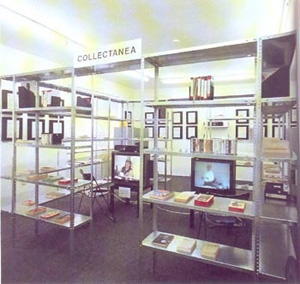Feature: Reviews
Institutional Critique and After
- Bing Theater
- Los Angeles County Museum of Art
- May 21, 2005
The symposium “Institutional Critique and After” sampled current issues relating to that movement in criticism, historical discourse, museum activities, and art practice. In the late 1960s and early 1970s artists such as Daniel Buren, Hans Haacke, and Michael Asher exposed the myth that culture is neutral, that the museum is disinterested, and that the representations of historical memory gathered there are objective. The term “institutional critique” emerged in the early 1980s and was given a definitive turn in an essay by Benjamin Buchloh published in the journal October in 1990: “Conceptual Art 1962-1969: From the Aesthetic of Administration to the Critique of Institutions.” Artists have continued to critique art’s material, social, and discursive contexts; Andrea Fraser, Fred Wilson, Renée Green, and Christian Phillip Muller are among the most prominent figures identified with the movement’s contemporary manifestations.
The day-long event grappled with the geographic limitations of past assessments, ongoing curatorial responses, and the question of the continuing validity of the contestatory methodologies deployed by artists. In a noble attempt at breadth, each of three panels was given over to scholarship, curating, and art work. The day’s central questions, as stated in the program’s introduction, turned on “the critical potential of art (and institutions) and whether—and if so how—they can stimulate social or political change.”
The first discussion, moderated by Alan Sekula, stretched across historical and critical issues. It included papers by Alexander Alberro, a scholar of conceptual art, and Isabelle Graw, editor of Texte zur Kunst, a German journal of contemporary criticism and theory based in Berlin. Sekula, a noted photo-conceptualist who has taught at California Institute of the Arts for many years, remarked on the polarization between the disparaged category of institutional critique and a valorized aesthetic of visual affect or pleasure in the Los Angeles art scene. Alberro focused on the Brazilian artist Cildo Meireles in a successful bid to rewrite the geographically limited canonical boundaries of institutional critique. Isabelle Graw deconstructed the terms “institution” and “critique” while alluding to the currently over-inflated art market, and, given that context, nostalgia for aesthetic autonomy. Both papers pointed to larger issues of the disintegration of a public sphere and the rise of corporatism, which were tackled early on in the work of Hans Haacke.
On the issue of globalization and privatization Alberro’s paper, which explored concerns similar to those of artists such as Fraser and Green and the curator Okwui Enwezor, was particularly relevant. His text argued for a lineage of institutional critique among Brazilian artists dating back to Helio Oiticica and Lygia Clark, and recently exemplified by Meireles’s project for Documenta 11, Disappearing Element/ Disappeared Element (2002). In this project water ice popsicles were sold for one Euro each by mobile vendors among the exhibition halls at Documenta in Kassel, Germany. In Alberro’s reading, Disappearing Element/Disappeared Element refers to a rich network of critical meanings: the imminent disappearance of clean public water supply on a global level; the consumption of art at international blockbuster exhibitions; the system of tourism in which such exhibitions are implicated; the role of the global biennale or manifesta in stimulating local economies; and the ever-increasing role of the artist as a service provider or project manager for the manufacture and distribution of commodities and spectacles. Foregrounding the strategies of audience involvement in Meireles’s work and referring to the critical reframing of cannibalism by other South American artists, Alberro positioned the project amidst work like Oiticica’s Penetrables and Parangoles’s and Lygia Clark’s Pocket Animal (1959). These art works by an earlier generation of Brazilian artists invited the viewer to manipulate objects, wear garments, or enter sensorily loaded environments.
Unfortunately the curatorial panel, “Institutional Critique, Inside Out,” did not engage with the issues put in place earlier in the day by Sekula, Alberro, and Graw. Although Christiana Paul, an Adjunct Curator of New Media Arts at the Whitney Museum, touched upon issues that digital art brought to bear on art world institutions, the other curators, Laura Furstenberg and Jens Hoffman, demonstrated a low degree of awareness of the movement’s history. Hoffman highlighted one of his shows, Artists Favorites (among his first at the London ICA), where he invited artists to choose their favorite art work for inclusion and display, thus deferring his curatorial choices. Such a curatorial process, guided by a watered-down concept borrowed from institutional critique, hardly invokes an investigation into the conditions of aesthetic production and meaning on the institutional level. In a particularly ironic moment, one curator declared that institutional critique had been totally reified by the academy. The remark was much contested in the discussions which followed where discussants pointed to newly emerging academic scholarship, of which Alberro’s presentation was a prime example, and what seemed to be the superficial cooptation of institutional critique for glib exhibition premises.
The three artists on the last panel, Renée Green, Ricardo Dominguez, and Andrea Fraser, addressed the way institutional critique could be thought to function in their work. Green’s video clips underscored that the site of production for what she referred to as “post-Institutional Critique” artwork is the office and that art is a form of intellectual production. Dominguez, a former member of Critical Art Ensemble and editor of Hacktivism: Network-Art-Activism [Autonomedia, Brooklyn, New York, 2001], posited his identity as an artist-activist working outside the institution using outlaw models of production, distribution, intervention, and disruption. Fraser, who had earlier that week spoken on a similar panel at the Guggenheim Museum in New York held in conjunction with Daniel Buren’s exhibition, saw herself in the third-generation of institutional critique. She described her practice as a critical methodology relating to a specific site and engaged with feminism. For Fraser, institutional critique is an ethical practice where the ambivalences and compromises, the politics of how one functions, become evident and integral to the work.
From the tenor of the symposium, it was obvious that the art community in and around Los Angeles has international horizons and a vital, thriving intellectual backbone. The Southern California Consortium of Art Schools (SoCCAS) together with the Los Angeles County Museum of Art co-presented the event. Such a collaboration of forces among San Francisco’s own arts institutions, faculty, and students, would surely serve the Bay Area arts community well. The intellectual resources are here: Andrea Fraser will be a visiting artist at the California College of Art (CCA) this fall, and with Larry Rinder’s presence at CCA and Okwui Enwezor’s and Renée Green’s appointments at the San Francisco Art Institute, the potential exists for program with such cross-engagement among the larger art world, local institutions, practicing artists, and curators.
Copyright Vivian Bobka, May 2005


